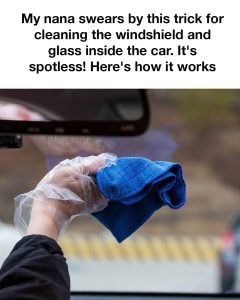My nana has always been full of wisdom, especially when it comes to simple yet brilliant household tips. One of her most reliable tricks is her unique method for cleaning car windshields and interior glass. It’s not fancy, and it doesn’t involve expensive products—but it works like magic. Over the years, I’ve seen her use this method countless times, and each time, the results have been the same: sparkling clean glass that looks professionally detailed. In this article, I’ll walk you through her exact process so you can achieve the same flawless results without spending a fortune.

Keeping your car’s windshield and windows clean isn’t just about looking good. It’s also about staying safe. Dirty or smudged glass can significantly impair your visibility while driving, especially at night or during rainy conditions. Glare from headlights or the sun can bounce off streaks and dirt, making it harder to see the road clearly. Clean glass reduces these risks and makes for a smoother, safer driving experience. And, of course, there’s something satisfying about sitting in a car with windows so clean they’re almost invisible. It gives your vehicle a polished, well-cared-for appearance that says a lot about how you treat your belongings.
You don’t need a shopping spree at the auto store to follow Nana’s method. The required materials are simple, inexpensive, and probably already sitting in your kitchen or laundry room. All you need is white vinegar, distilled water, a spray bottle, a microfiber cloth, and a soft sponge. That’s it. The vinegar and distilled water create a powerful cleaning solution that cuts through dirt, grease, and grime, all without leaving behind streaks. And the microfiber cloth ensures a lint-free, polished finish that’s far superior to paper towels or standard rags.
Start by mixing equal parts of white vinegar and distilled water in your spray bottle. Shake the mixture well to make sure it’s fully blended. Once your solution is ready, spray it liberally onto the glass surfaces of your vehicle—both inside and out. Don’t be shy with the amount; the goal is to loosen up any dirt, residue, or smudges. Use a soft sponge to gently scrub the glass, especially focusing on trouble spots like bird droppings, bug splatters, or greasy fingerprints. Then, using a clean microfiber cloth, wipe down the glass in slow, circular motions. This technique helps lift the dirt and avoid creating streaks. For the final step, flip to a dry section of the cloth and give the glass one more pass to buff it to a brilliant shine.
So why does this method work so well? The secret lies in the vinegar. Vinegar is a natural acid, which means it breaks down grease and grime quickly and effectively. It also helps dissolve mineral deposits that can form from rainwater or tap water. When paired with distilled water—which contains no minerals—it creates a fast-evaporating solution that doesn’t leave behind spots or streaks. The microfiber cloth is equally important because its fine fibers are specially designed to trap and lift away dust and moisture without scratching the surface. It’s a winning combination of science and simplicity that gets the job done without any harsh chemicals.
Many people default to store-bought glass cleaners, which may seem more convenient but often come with drawbacks. These cleaners can leave behind residue, especially if overused or applied improperly. Some even contain chemicals that aren’t safe for tinted windows or certain types of interior trim. Nana’s method, by contrast, is completely natural and environmentally friendly. It’s gentle on your car, safe for your skin, and doesn’t introduce unnecessary toxins into your living space. Plus, it saves you money and reduces waste—no empty plastic bottles to throw away, no specialized wipes, just good old-fashioned cleaning with items you already have.
If you want to maintain consistently clean glass, don’t wait for your windshield to get filthy. Get into the habit of cleaning it regularly. A quick wipe-down once every week or two can prevent buildup and make each cleaning session easier. Try to avoid parking your car under trees where sap or pollen can accumulate on the windshield. Use a sunshade when parked to protect the inside glass from sun damage and to reduce heat that can bake grime onto the surface. And always keep a microfiber cloth in your glove compartment—it’s handy for quick cleanups when you’re on the go or for wiping away condensation during colder months.
There are also a few common mistakes to watch out for. Never use paper towels or napkins to clean glass. They may seem convenient, but they often leave behind lint and can even scratch the surface over time. Avoid cleaning your windows in direct sunlight; the heat can cause the solution to dry too quickly, leaving streaks behind. Always make sure your microfiber cloth is clean and dry—if it’s dirty or damp, you’ll just be spreading grime around. Lastly, be gentle when scrubbing. You don’t need to apply a lot of pressure; let the vinegar solution do the work.
People often have questions about whether this method is safe for all types of glass. The answer is yes—even tinted windows are safe. Since the solution doesn’t contain ammonia or abrasive chemicals, it won’t damage the tint or strip it away. As for how often to clean your windows, once a month is a good general rule. However, if you live in an area with high dust levels or heavy pollution, you may want to clean them more frequently. And while vinegar is the top choice for effectiveness, lemon juice is a pleasant-smelling alternative that also works well on grime, thanks to its natural acidity.
When all is said and done, maintaining clean car glass is one of the simplest yet most impactful ways to enhance your driving experience. It improves visibility, keeps you safer on the road, and makes your car look cared for and fresh. With just a few basic ingredients and a little bit of time, you can replicate Nana’s tried-and-true method and enjoy the benefits every time you get behind the wheel. It’s a small effort with a big payoff—and one that’s well worth adding to your car care routine.





